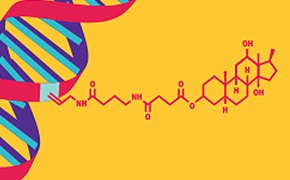Nucleic Acid Labeling

Non-radioactive nucleic acid labeling technologies are routinely used as a safer alternative for DNA and RNA detection needs compared to radiolabeled compounds. Our portfolio offers a range of nucleic acid labeling reagents, including Biotin RNA Labeling Mix, Fluorescein RNA Labeling Mix, and Digoxigenin (DIG) RNA and DNA labeling and detection reagents. Explore our offerings and discover which nucleic acid labeling reagent is best for your workflow needs.
Products
DIG DNA Labeling and Detection
Digoxigenin (DIG) labeling technology is an ideal alternative to hazardous radioactive isotopes for nucleic acid labeling. Flexibly use colorimetric, luminescent or fluorescent signal detection and achieve high sensitivity with low background in very short exposure times. Use robust procedures and established protocols for low background and a high signal-to-noise ratio. As exclusive distributors of the Roche DIG System, we are committed to providing researchers with the high specificity and sensitivity that they require to detect nucleic acids and enable their next breakthrough. The DIG System offers several benefits:
- Specificity: DIG antibodies do not bind to other substrates.
- Versatility: Use DIG labeled probes for filters and in situ hybridization.
- Proven: Thousands of publications show why DIG is superior to radioactivity.
- Safety: Label and detect without the dangers or inconvenience of radioactivity.
For additional information on DIG protocols, reagents, and resources, please visit our DIG Labeling Methods resource page.
Digoxigenin (DIG) Labeling Methods
Originally based on a steroid isolated from digitalis plants, the only known source of digoxigenin, the DIG system is a powerful tool for nucleic hybridization analysis. Provided the limited natural occurrence of this molecule in nature makes this an ideal labeling molecule as the anti-DIG antibody does not bind to other biological molecules, ensuring high specificity to the target. Once the stabilized nucleic acid hybridizes with the DIG-labeled probe, anti-digoxigenin antibodies coupled with either horseradish peroxidase (HRP) or alkaline phosphatase, rhodamine or fluorescein are used for subsequent chemiluminescent or fluorescent detection.
To continue reading please sign in or create an account.
Don't Have An Account?